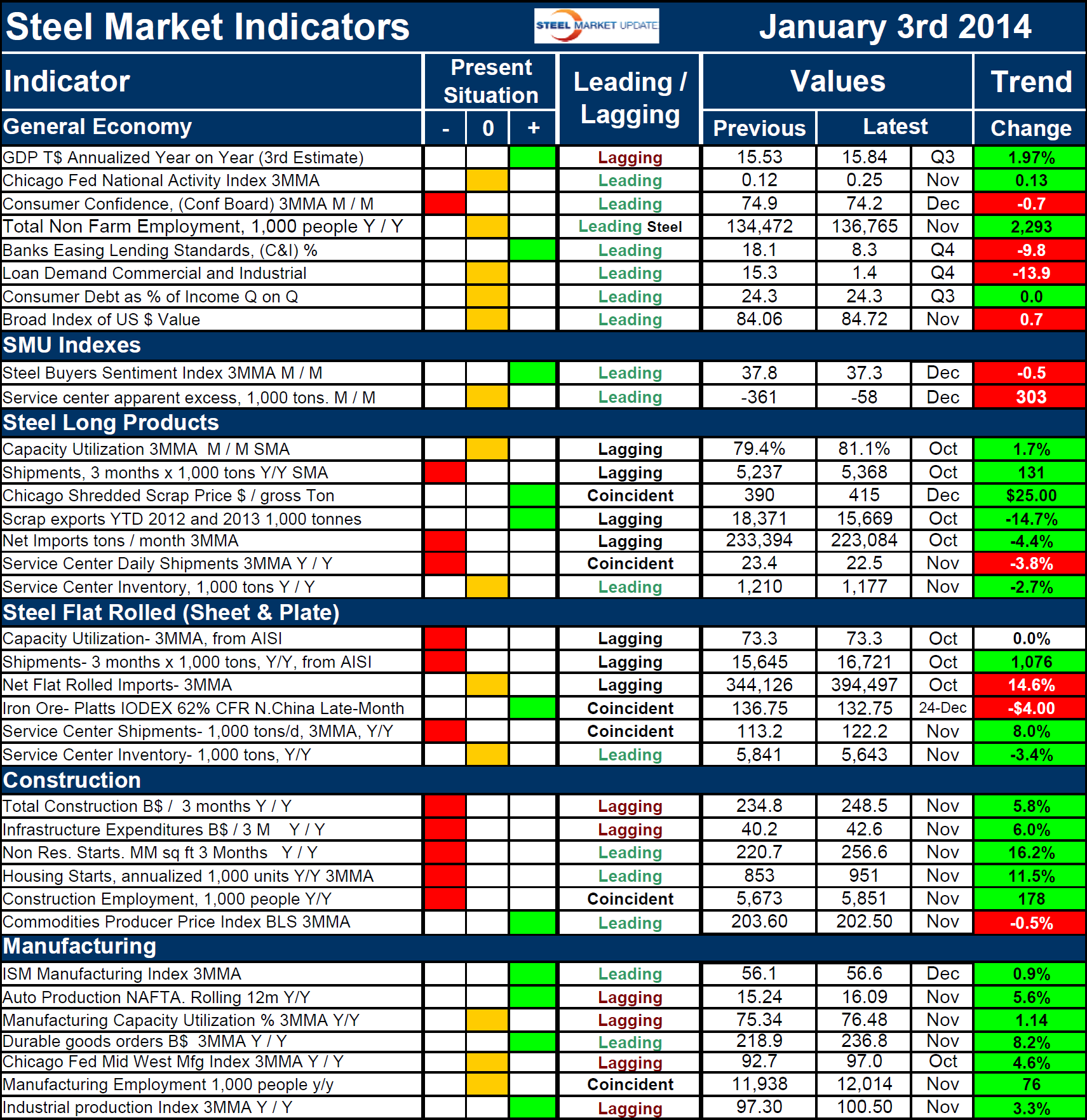Economy

SMU Key Market Indicators
Written by Peter Wright
January 2, 2014
An explanation of the Key Indicators concept is given at the end of this piece for those readers who are unfamiliar with it.
The total number of indicators considered at present is thirty six. The present situation of eleven of the indicators based on historical standards was positive on December 28, the same as on November 21, twelve were negative and thirteen considered to be neutral. This was a decrease of one in the negative category as the capacity utilization of the long products mills was moved to neutral with a value of 81.1 percent. This continues to be the best result since this analysis was first published in March when seven indicators were positive by historical standards and fourteen were negative. The present situation of the general economy is pretty much in a holding pattern with five indicators in neutral, two positive and one negative. The SMU Buyers Sentiment Index and the SMU Service Center Apparent Excess statistics are both currently positive by historical standards. Present situation indicators for long and flat steel products are similar with shipments at both the mill and service levels low by historical standards. All the construction indicators, except the producer price index of commodities, are negative at present. All the manufacturing indicators are either positive or neutral.
The quantitative analysis of the value of each indicator over time is shown in the “Trend” column. At present, trends are moving in the right direction. Twenty five of thirty six indicators are improving with one indicator unchanged. This is a decrease of two in the deteriorating category. Trends in the general economy were unchanged with four positives and four negatives. We expect this ratio to move towards positive in 2014 based on recent economic data. Both the SMU indexes had a negative trend. The buyer’s sentiment is still optimistic though it declined slightly from the November value. The service center apparent excess decreased markedly from negative 361,000 tons to negative 58,000 tons driven by a year-over-year inventory increase and shipment decrease. The only negative trend in the steel long products sector was a decline in daily service center shipments on a three month moving average basis year-over-year. Capacity utilization of the flat rolled sector was unchanged at 73.3 percent Net imports increased and the price of iron ore decreased. Shipments increased from both mills and service centers on a year-over-year basis. All the construction indicators except the producer price index of commodities are improving as are all of the manufacturing indicators.
The key indicators analysis confirms our experience that the current market is not great but tells us that most trends which are quantified are moving in the right direction and there is positive momentum. The trends specific to the steel market are being positively driven by the manufacturing sector and negatively by construction. SMU has several benchmark analyses that show steel demand to be below the historical norm for this stage of a recovery. This is because the depression in non residential and housing construction was so extreme that it will be years before the pre recessionary levels are reached. In addition government funded infrastructure work is still depressed.
We believe a continued examination of both the present situation and direction will be a valuable tool for corporate business planning.
Explanation: The key indicators chart is designed to give a snapshot of the steel market on a specific date. The chart is stacked vertically to separate the primary indicators of the general economy, of proprietary Steel Market Update indices, of both flat rolled and long product market indicators and finally of construction and manufacturing indicators. The indicators are classified as leading, coincident or lagging as indicated.
Columns in the chart are designed to differentiate between the current situation and the direction in which the market is headed. The present situation is sub-divided into, below the historical norm (-), (OK), and above the historical norm (+). The “Values” section of the chart is a quantitative definition of the market’s direction. In cases where seasonality is an issue, the evaluation of market direction is made on a three month moving average basis and compared year over year to eliminate this effect. Where seasonality is not an issue concurrent periods are compared. The date of the latest data is identified in the third values column. Values will always be current as of the date of publication. Finally the far right column quantifies the trend as a percentage or numerical change with color code classification to indicate positive or negative direction.

Peter Wright
Read more from Peter WrightLatest in Economy

ISM September survey captures deepening manufacturing gloom
The Institute for Supply Management’s (ISM) latest monthly report on manufacturing reflects a bleak view of American industry in September.

Key industries concerned over government shutdown’s impact on steel, manufacturing
Trade groups cautioned that a prolonged shutdown could strain US industry.

Chicago Business Barometer catches cold winds of contraction in September
The Chicago Business Barometer's September reading indicates a softening in overall business activity in the Midwest for the third consecutive month, with new orders and backlogs retreating further.

Metalforming market sentiment takes a dive in September: PMA
Metalforming manufacturers anticipate a decrease in near-term conditions, according to the Precision Metalforming Association's (PMA) Business Conditions Report for September.

AIA: Architecture firms still under pressure
Architecture firms reported a modest improvement in billings through August, yet business conditions remained soft, according to the latest Architecture Billings Index (ABI) release from the American Institute of Architects (AIA) and Deltek.

